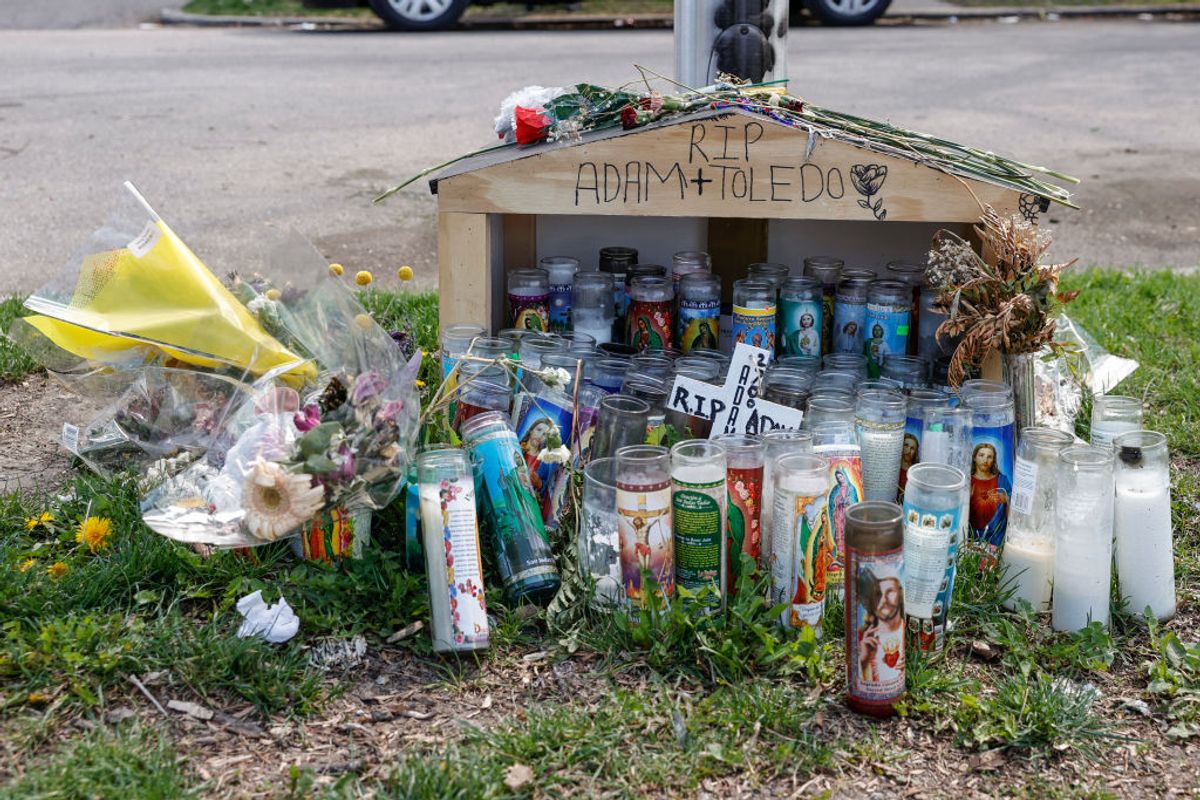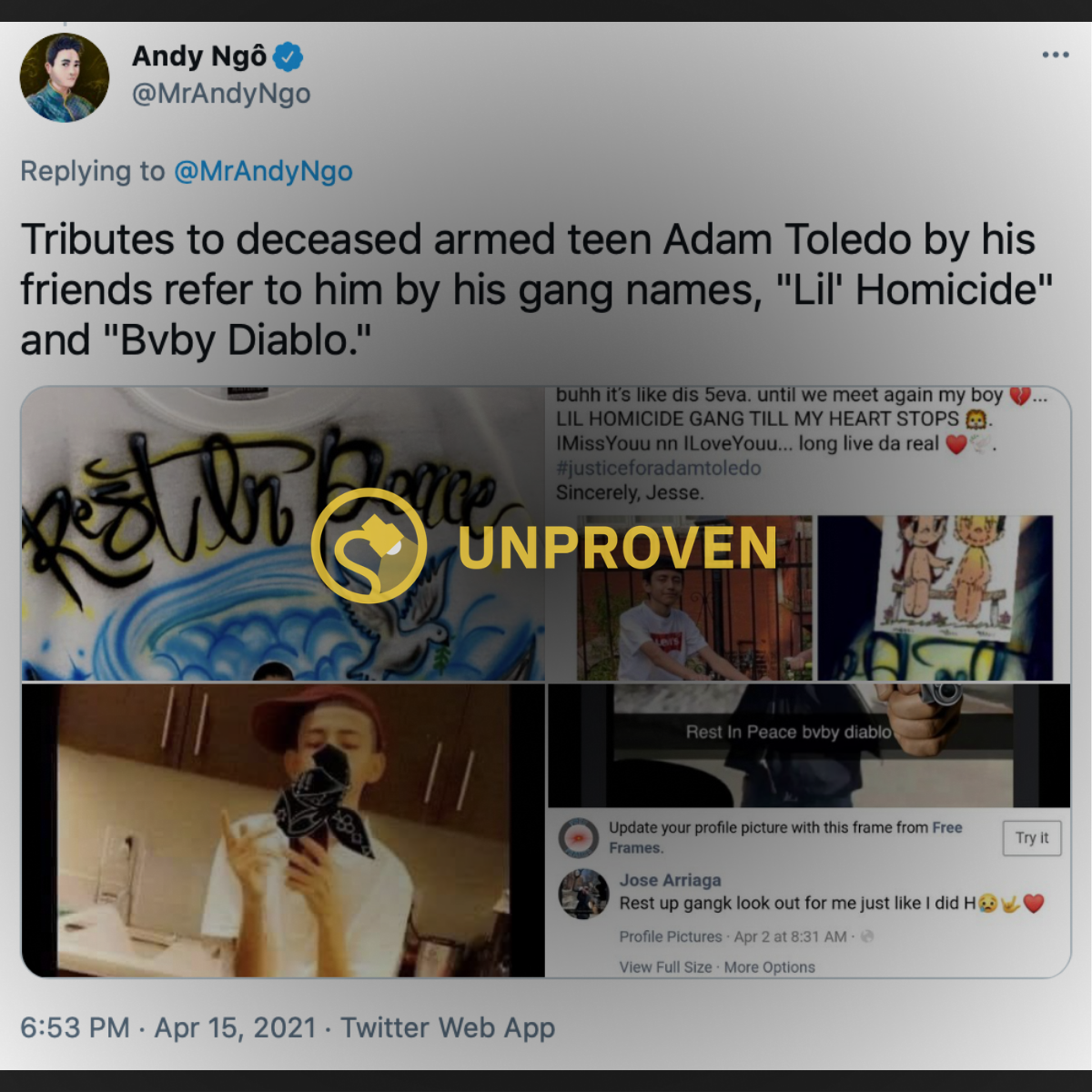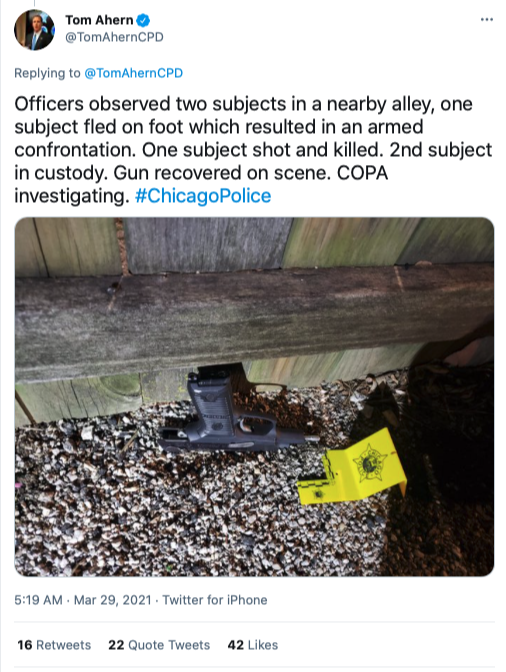While no verified evidence substantiated the claim, it was possible Toledo associated with members of the Latin Kings gang without his loved ones' knowing or acquiring a criminal record. Also, police did not get back to us regarding whether Toledo was on their radar as a member of the gang.
On April 15, 2021, Chicago officials released police body-camera footage showing an officer chasing a 13-year-old boy down an ally in the city's Little Village neighborhood and fatally shooting him once in the chest.
As the graphic video of Adam Toledo's death circulated online, rumors surfaced attempting to rationalize the white officer's actions by calling the seventh-grader a member of one of America's most violent street gangs, the Latin Kings.
"[Toledo] was known in gang circles as 'Lil Homicide' and 'Bvby Diablo'," wrote Andy Ngô, a prolific spreader of misinformation on social media, in tweets including screenshots that he framed as memorial messages by people who knew the boy.
However, no evidence we found substantiated those claims — that Toledo participated in organized street crime and/or considered himself a member of the Latin Kings, or that "Lil Homicide" or "Bvby Diablo" were authentic nicknames for him, and that those monikers related to his social status or circle. In fact, the authenticity of the images in Ngô's post was unknown, meaning it was possible the screenshots did not depict real condolences by people who knew Toledo.
Below, we compiled reporting from reputable news outlets and other evidence to lay out the circumstances of Toledo's killing that ignited protests over alleged police brutality's effect on Black and Latino communities, the circumstances under which the internet perpetuated the above-mentioned rumors about the Latin Kings, and proof that the teenager had no history with Illinois' criminal justice system.
What Happened on the Night Toledo Died?
Elizabeth Toledo, the teen's mother, told reporters her son had gone missing for several days in late March, and that she contacted Chicago police to help find him. Eventually, she said, he returned home the night of March 28.
It's unknown why, under what circumstances, or how the boy wound up in an alley with an older man (whom authorities later identified as 21-year-old Ruben Roman of Chicago) hours later that night.
But around 3 a.m., two Chicago police officers confronted the 13-year-old and Roman while investigating gunshots in Little Village, a predominately Latino neighborhood on Chicago's southwest side. According to prosecutors, Roman had fired a gun at a passing car.
Over the course of seconds, one of the officers — later identified as 34-year-old Eric Stillman — exited his squad car and started running after Toledo and Roman, according to Snopes' analysis of footage from Stillman's body-worn camera. As another officer supposedly caught up to Roman, Stillman kept chasing the teen, yelling "Police! Stop! Stop right fucking now!"
Then, in the split seconds before the police officer opened fire, Toledo was recorded holding what appeared to be a handgun, dropping that item, turning toward the cop and starting to raise his arms, per our frame-by-frame analysis of the video.
He was pronounced dead at the scene, and the body-camera indeed recorded a handgun on the ground next to the boy's body. Below is a tweet authored by Chicago Police Spokesman Thomas Ahern just hours after the shooting:
Another police document from that night, titled "Tactical Response Report" (a portion of which is displayed below), said officers were not pursuing the subject (Toledo) for "drug-related" or "gang-related" reasons, and that the boy "did not follow verbal direction" and presented an "imminent threat" with a semi-automatic pistol.
Police initially arrested Roman on a misdemeanor count of resisting arrest. At first, he gave authorities a fake name for the teen, and then denied knowing who he was with in the alley, reported the Chicago Tribune. (Later, the boy's mother told the Chicago Sun-Times she did not know Roman.)
Then, weeks later, authorities arrested Roman in connection with an unrelated case and added on felony charges of alleged child endangerment, aggravated unlawful use of a weapon, and reckless discharge of a firearm for his actions on March 29 involving Toledo. He was in jail at the original publication of this report.
Was Toledo Part of Latin Kings Gang?
This much was true: The area of Toledo's shooting is a stronghold of the Latin Kings street gang — a sophisticated drug-trafficking operation with factions across the nation, leaders in and out of prison, and a violent reputation. Members often pledge their allegiance as children or pre-teens.
Also accurate was that the Chicago Sun-Times reported the city's police department issued an "officer safety alert" on April 1 (three days after Toledo's shooting) that claimed gang leaders in the same area told ranking members to shoot at unmarked police vehicles as a form of retaliation. However, it was unclear against what, exactly, Latin Kings were reportedly retaliating, or if that alleged threat against police was related to Toledo's killing.
Furthermore, Alderman George Cardenas, who represents portions of Little Village, appeared to affirm speculation about the boy's alleged criminal activity by making the following comment at a April 5 news conference:
"This young man had nobody," Cardenas said. "It's sad to say that this young man, and I've heard rumors, nobody. Nobody that could help him, except a gang. Nobody could claim him as their own, except a gang. So shame on us. I own that."
That purported narrative surfaced again, more than a week later, when the leader of the city's largest police union appeared on CNN to discuss the case with anchor Chris Cuomo. Union President John Catanzara (who, as of this writing, faced termination pending the outcome of investigations into a variety of complaints, including that he filed a false police report against the department's former superintendent in 2018) alleged on "Cuomo Prime Time" on April 15, according to the interview's audio obtained by Snopes:
"This subject [Toledo] was a Latin King gang member. He did have a fresh tattoo on his arm that wasn't even healed, it was so fresh," he said. "The gangs take advantage of these poor, misguided, young kids, and they use them for the own gain."
To investigate that claim — that Toledo had a new Latin Kings tattoo on his arm — we asked the Cook County Medical Examiner's Office for a copy of Toledo's autopsy report, as well as any other documentation outlining the office's investigation into his death. (Medical investigators often take note of deceased people's significant body modifications, including tattoos.) On June 3, Cook County's public records office fulfilled our request for those records, including Toledo's "Report of Postmortem Examination." That record stated:
In other words, Toledo indeed had a tattoo on his right wrist, though medical examiners did not make note of the design in their analysis of his body. (We contacted the office for more details, and we were waiting to hear back, as of mid-June.) There was no indication the ink represented the Latin Kings, and it was unclear how, or via what means, the police union president came to that purported conclusion.
Meanwhile, the boy's family condemned stories framing Toledo as a "poor, misguided" teen without a healthy support system. On multiple occasions, Adeena Weiss-Ortiz, the family's attorney, and Toledo's mother stressed that he was loved and supported, had a clean criminal record before his death, and did not condone violence. They said in a statement to the news media:
We do, however, want to correct the hurtful and false mischaracterization of Adam as a lonely child of the street who had no one to turn to. This is simply not true. [...] He lived with his mother, his 90-year-old grandfather, and two of his siblings. His father was in his life. They all loved him very much. The Toledo family is a close-knit family. They look after each other. Adam attended Gary Elementary School where he had the support of his teachers and his classmates. Adam was not alone.
In an interview with news outlet Block Club Chicago, the lawyer stated frankly: “Adam … was a good kid without a criminal record."
Based on our analysis of Illinois court records, he did not appear to have a criminal record (with the caveat that only minors who are involved in crimes, and their relatives or lawyers, generally have access to specific arrest and court records).
Confirming that finding, Chicago Police Superintendent David Brown said at an April 5 news conference that medical investigators scanned the boy's fingerprints on multiple separate occasions after his death to see if they matched those of anyone who had been arrested. "There were no matching records in any database," he said.
Furthermore, we asked the Chicago Police Department if officers had any interactions with Toledo before the fatal confrontation and if, or to what extent, they saw any connection between him and the Kings. We also asked whether police had any evidence to confirm or deny Catanzara's allegation that the teen had a Latin Kings tattoo.
Citing the active investigation into his death, a police spokesperson did not answer our questions and referred us to the independent agency looking into Stillman's deadly use of force, called the Civilian Office of Police Accountability. (Here's that agency's preliminary report about Toledo's shooting and all related materials, including the body-camera video).
We presented the same questions with respect to Toledo's alleged gang affiliations to Ephraim Eaddy, a spokesperson for that board, and he responded to us with this emailed statement:
Thank you for your inquiry. However because this is an open investigation we cannot provide details. Once our investigation has concluded we will post all findings to our website and notify the public.
Also, we should note here: Weiss-Ortiz did not return our request for an interview for this investigation -- including questions whether the alleged nicknames of "Lil Homicide" and "Bvby Diablo" were authentically used by Toledo's social circle and, if so, whether they had anything to do with the Kings.
Until we get additional information to definitively confirm or deny the underlying claim, we're issuing a rating of "Research in Progress."
Was the Chicago Police Officer in Danger?
When officials released the video of Toledo's death in mid-April, some viewers framed it as alleged evidence of Chicago police's eagerness to use lethal force against non-white suspects, regardless of their level of danger for officers. Weiss-Ortiz said at a news conference after the video's release, according to recordings of that media event:
"Adam during his last second of life did not have a gun in his hand," she said. "The officer screamed at him, ‘Show me your hands.’ Adam complied, turned around -- his hands were empty when he was shot in the chest.”
On the other hand, Stillman’s attorney, Tim Grace, defended the officer's actions, saying he faced a "life threatening and deadly force situation" in the alley where Toledo died, The Associated Press reported. (We attempted to reach Grace ourselves, but he did not return Snopes' request for comment.)
“The juvenile offender had the gun in his right hand ... looked at the officer which could be interpreted as attempting to acquire a target and began to turn to face the officer attempting to swing the gun in his direction,” Grace said. “All prior attempts to deescalate and gain compliance with all of the officer’s lawful orders had failed.”
Whether Stillman, a six-year veteran of the department, indeed acted appropriately, under terms outlined in police policies, state statutes and city laws, remained undetermined. A 1989 Supreme Court ruling said officers’ use of force may be legal if they truly believed their lives were threatened in the moment — even though, in hindsight, it becomes clear they weren’t actually in danger, reported The Associated Press.
As of this writing, he was on administrative duty, a routine step for officers who kill civilians, and the Cook County state's attorney's office had not said whether it was considering charges against the police officer.
As far as the unsubstantiated rumors around Toledo's alleged gang ties, we've addressed similar assertions before. For decades, corners of the internet have searched for incriminating details about the lives of non-white men killed by police, no matter those details' relevancy to their deaths.
In many such cases, the accusations are exaggerated or misleading recounts of the deceased's run-ins with law enforcement, often omitting context to make sense of prosecutors' allegations against them. (See here for our investigations into the criminal histories of George Floyd, Rayshard Brooks, and Daunte Wright after police killed them, at the request of Snopes readers.)




